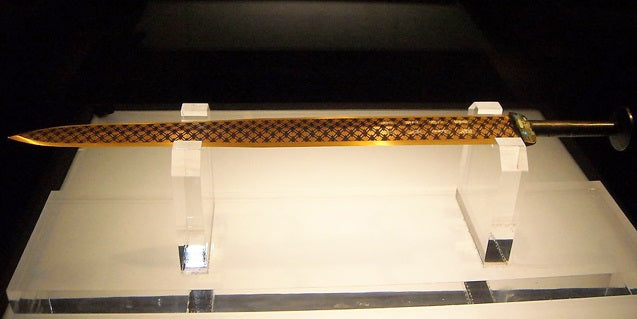The Sword Of Goujian
The Sword Of Goujian

An Ancient Chinese Sword
At Swords of Northshire, we make weapons forged through traditional Japanese methods, but these techniques were often shared with the distant blacksmiths in China. Before Japan became such an isolated nation, the two countries often exchanged smithing techniques to improve the performance of their weapons.
One such sword that shows the similarities between Japanese and Chinese weapons is the Sword of Goujian. Found in Hubei, China in 1965, it has several remarkable features. Learn more about this ancient Chinese sword when you read on for an analysis by our experts.
Unique Features
One of the most remarkable features of the Sword of Goujian is its unusual sharpness and resistance to tarnishing. Despite languishing in an underwater tomb for over 2,000 years, the metal of the blade was still whole and shining brightly.
According to the engraving on the blade, this sword was made for a Chinese king, the King of Yue. There are two characters that haven’t been translated yet that could be the name of the specific king or the signature of the bladesmith who crafted the weapon.
Specifications

The Sword of Goujian is a medium-sized sword that weighs just under two pounds. It measures 55.6 cm in length and is 4.6 cm wide at the base. The blade is 47.2 cm long, and the hilt is an additional 8.4 cm. It has a minimalist guard and the hilt is bound in silk.
Similarities to Japanese Swords
There are many similarities between the ancient Sword of Goujian and traditional Japanese Samurai swords. While the shape of the blade is more closely related to the symmetrical European broadsword, nearly every other feature is remarkably similar to a katana or wakizashi.
First, the measurements of the weapon fall within the strictures of a wakizashi blade. Whereas European swords of the same shape generally weighed over 3 lbs and measured over 150 cm, the Sword of Goujian is lightweight and short. The binding on the sword grip is also more like the bindings on Japanese weapons — utilizing silk instead of leather or cotton. The minimalist guard is another similarity to Japanese weapons and probably went a long way towards lightening the total weight of the sword.
The most telling commonality between this sword and Japanese weapons is the metal composition. The utilization of impure materials that are folded to create a stronger blade is exactly the same as the Japanese method. While the Japanese used Tamahagane steel, this blade is a combination of copper and tin that was folded many times to ensure that the spine of the blade was the more flexible copper and the edges were the harder tin.
Your Sword Experts

Swords of Northshire are your experts on all things swords. Whether you’re looking to buy a custom-crafted weapon or you simply want to learn more about the history of sword making, visit us first!
Best Sellers
- Regular Price
- from $199.99
- Sale Price
- from $199.99
- Regular Price
-
- Unit Price
- per
- Regular Price
- from $299.00
- Sale Price
- from $299.00
- Regular Price
-
- Unit Price
- per
- Regular Price
- from $199.00
- Sale Price
- from $199.00
- Regular Price
-
$0.00
- Unit Price
- per
- Regular Price
- from $319.00
- Sale Price
- from $319.00
- Regular Price
-
- Unit Price
- per
- Regular Price
- from $619.00
- Sale Price
- from $619.00
- Regular Price
-
- Unit Price
- per
- Regular Price
- from $249.00
- Sale Price
- from $249.00
- Regular Price
-
- Unit Price
- per
- Regular Price
- from $339.00
- Sale Price
- from $339.00
- Regular Price
-
- Unit Price
- per
- Regular Price
- from $219.00
- Sale Price
- from $219.00
- Regular Price
-
- Unit Price
- per
- Regular Price
- from $364.00
- Sale Price
- from $364.00
- Regular Price
-
- Unit Price
- per
- Regular Price
- from $519.00
- Sale Price
- from $519.00
- Regular Price
-
- Unit Price
- per









